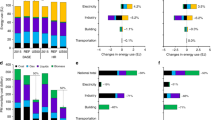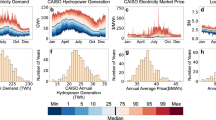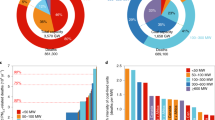Abstract
We explore how nuclear shut-downs in the United States could affect air pollution, climate and health with existing and alternative grid infrastructure. We develop a dispatch model to estimate emissions of CO2, NOx and SO2 from each electricity-generating unit, feeding these emissions into a chemical transport model to calculate effects on ground-level ozone and fine particulate matter (PM2.5). Our scenario of removing nuclear power results in compensation by coal, gas and oil, resulting in increases in PM2.5 and ozone that lead to an extra 5,200 annual mortalities. Changes in CO2 emissions lead to an order of magnitude higher mortalities throughout the twenty-first century, incurring US$11–180 billion of damages from 1 year of emissions. A scenario exploring simultaneous closures of nuclear and coal plants redistributes health impacts and a scenario with increased penetration of renewables reduces health impacts. Inequities in exposure to pollution are persistent across all scenarios—Black or African American people are exposed to the highest relative levels of pollution.
This is a preview of subscription content, access via your institution
Access options
Access Nature and 54 other Nature Portfolio journals
Get Nature+, our best-value online-access subscription
$29.99 / 30 days
cancel any time
Subscribe to this journal
Receive 12 digital issues and online access to articles
$119.00 per year
only $9.92 per issue
Buy this article
- Purchase on Springer Link
- Instant access to full article PDF
Prices may be subject to local taxes which are calculated during checkout






Similar content being viewed by others
Data availability
All data necessary to do the analysis are available at https://doi.org/10.5281/zenodo.7650413. This includes the diagnostic files necessary to rerun the chemical transport model simulations and the processed data for analysis. Data to run GEOS-Chem are available on its data portals68. Data to run the US-EGO model are publicly available through EIA forms 923 and 906/920 (ref. 69), EIA form 930 (ref. 70), the EPA NEEDS v.5.16 platform43, as well as the EPA eGRID database56. We use publicly available census data60 for state-level population estimates and census data63 for evaluation of impacts by race and ethnicity. We use the Global Burden of Disease for mortality rates by state59. EPA Air Quality System and IMPROVE monitor data for observation comparisons to GEOS-Chem model output are publicly available71,72. We use cartopy for our basemaps73.
Code availability
All code necessary for the analysis is available on Zenodo. This includes (1) US-EGO model code available at https://zenodo.org/badge/latestdoi/601766084 and (2) analysis code available at https://zenodo.org/badge/latestdoi/248010532. GEOS-Chem is an open-access community model and can be downloaded according to instructions on its website74.
References
Annual Energy Outlook 2021 with Projections to 2050 (EIA, 2021).
Larson, E. et al. Net-Zero America: Potential Pathways, Infrastructure, and Impacts (Princeton Univ., 2021); https://netzeroamerica.princeton.edu/the-report
Markandya, A. & Wilkinson, P. Electricity generation and health. Lancet 370, 979–990 (2007).
Fell, H., Gilbert, A., Jenkins, J. D. & Mildenberger, M. Nuclear power and renewable energy are both associated with national decarbonization. Nat. Energy 7, 25–29 (2022).
Kharecha, P. A. & Hansen, J. E. Prevented mortality and greenhouse gas emissions from historical and projected nuclear power. Environ. Sci. Technol. 47, 4889–4895 (2013).
McDuffie, E., Martin, R., Yin, H. & Brauer, M. Global Burden of Disease from Major Air Pollution Sources (GBD MAPS): A Global Approach (Health Effects Institute, 2021); https://www.healtheffects.org/publication/global-burden-disease-major-air-pollution-sources-gbd-maps-global-approach
Vohra, K. et al. Global mortality from outdoor fine particle pollution generated by fossil fuel combustion: results from GEOS-Chem. Environ. Res. 195, 110754 (2021).
Raising Awareness of the Health Impacts of Coal Plant Pollution (Clean Air Task Force, 2023); https://www.catf.us/work/power-plants/coal-pollution/
Jenkins, J. What’s Killing Nuclear Power in US Electricity Markets? Drivers of Wholesale Price Declines at Nuclear Generators in the PJM Interconnection (MIT CEEPR, 2018); http://ceepr.mit.edu/publications/working-papers/677
H.R.5376—117th Congress (2021–2022): Inflation Reduction Act of 2022 (Congress Gov, archive location 16 August 2022); https://www.congress.gov/bill/117th-congress/house-bill/5376
New York’s Indian Point Nuclear Power Plant Closes After 59 Years of Operation (EIA, 30 April 2021); https://www.eia.gov/todayinenergy/detail.php?id=47776
Severnini, E. Impacts of nuclear plant shutdown on coal-fired power generation and infant health in the Tennessee Valley in the 1980s. Nat. Energy 2, 17051 (2017).
Davis, L. & Hausman, C. Market impacts of a nuclear power plant closure. Am. Econ. J. Appl. Econ. 8, 92–122 (2016).
Jarvis, S., Deschenes, O. & Jha, A. The Private and External Costs of Germany’s Nuclear Phase-Out (NBER, 2019); https://www.nber.org/papers/w26598
Seinfeld, J. & Pandis, S. Atmospheric Chemistry and Physics: From Air Pollution to Climate Change 2nd edn (Wiley, 2006).
Di, Q. et al. Air pollution and mortality in the Medicare population. New England J. Med. 376, 2513–2522 (2017).
Turner, M. C. et al. Long-term ozone exposure and mortality in a large prospective study. Am. J. Resp. Crit. Care Med. 193, 1134–1142 (2016).
Aborn, J. et al. An Assessment of the Diablo Canyon Nuclear Plant for Zero-Carbon Electricity, Desalination, and Hydrogen Production (Stanford Univ., 2021).
Tessum, C. W. & Marshall, J. D. Air Quality and Health Impacts of Potential Nuclear Electricity Generator Closures in Pennsylvania and Ohio (NEI, 2019); https://depts.washington.edu/airqual/reports/Nuclear%20Replacement%20Air%20Quality.pdf
Lew, D. et al. How Do High Levels of Wind and Solar Impact the Grid? The Western Wind and Solar Integration Study (US Department of Energy, 2010); http://www.osti.gov/servlets/purl/1001442/
Tessum, C. W. et al. Inequity in consumption of goods and services adds to racial-ethnic disparities in air pollution exposure. Proc. Natl Acad. Sci. USA 116, 6001–6006 (2019).
Hajat, A., Hsia, C. & O’Neill, M. S. Socioeconomic disparities and air pollution exposure: a global review. Curr. Environ. Health Rep. 2, 440–450 (2015).
Liu, J. et al. Disparities in air pollution exposure in the United States by race/ethnicity and income, 1990–2010. Environ. Health Perspect. 129, 127005 (2021).
Tessum, C. W. et al. PM2.5 polluters disproportionately and systemically affect people of color in the United States. Sci. Adv. https://doi.org/10.1126/sciadv.abf4491 (2021).
Spiller, E., Proville, J., Roy, A. & Muller, N. Z. Mortality risk from PM2.5: a comparison of modeling approaches to identify disparities across racial/ethnic groups in policy outcomes. Environ. Health Perspect. 129, 127004 (2021).
Busby, J. W. et al. Cascading risks: understanding the 2021 winter blackout in Texas. Energy Res. Social Sci. 77, 102106 (2021).
Bressler, R. D. The mortality cost of carbon. Nat. Commun. 12, 4467 (2021).
Executive Order 12866 of September 30, 1993 Regulatory Planning and Review (Federal Register, 1993); https://www.archives.gov/files/federal-register/executive-orders/pdf/12866.pdf
Mortality Risk Valuation (US EPA, 2014); https://www.epa.gov/environmental-economics/mortality-risk-valuation
Social Cost of Carbon, Methane, and Nitrous Oxide (Interagency Working Group on Social Cost of Greenhouse Gases, US Government, 2021); https://web.archive.org/web/20221212061639/https://www.whitehouse.gov/wp-content/uploads/2021/02/TechnicalSupportDocument_SocialCostofCarbonMethaneNitrousOxide.pdf
Rennert, K. et al. Comprehensive evidence implies a higher social cost of CO2. Nature 610, 687–692 (2022).
Driscoll, C. T. et al. US power plant carbon standards and clean air and health co-benefits. Nat. Clim. Change 5, 535–540 (2015).
Kyne, D. & Bolin, B. Emerging environmental justice issues in nuclear power and radioactive contamination. Int. J. Environ. Res. Public Health 13, 700 (2016).
Kuletz, V. L. The Tainted Desert: Environmental and Social Ruin in the American West (Routledge, 1998).
Stoutenborough, J. W., Sturgess, S. G. & Vedlitz, A. Knowledge, risk, and policy support: public perceptions of nuclear power. Energy Policy 62, 176–184 (2013).
Brugge, D. & Goble, R. The history of uranium mining and the Navajo people. Am. J. Public Health 92, 1410–1419 (2002).
Goforth, T. & Nock, D. Air pollution disparities and equality assessments of US national decarbonization strategies. Nat. Commun. 13, 7488 (2022).
Gallagher, C. & Holloway, T. Integrating air quality and public health benefits in U.S. decarbonization strategies. Front. Public Health https://doi.org/10.3389/fpubh.2020.563358 (2020).
Abel, D. W. et al. Air quality-related health benefits of energy efficiency in the United States. Environ. Sci. Technol. 53, 3987–3998 (2019).
Buonocore, J. J. et al. Health and climate benefits of different energy-efficiency and renewable energy choices. Nat. Clim. Change 6, 100–105 (2016).
Vodonos, A., Awad, Y. A. & Schwartz, J. The concentration–response between long-term PM2.5 exposure and mortality: a meta-regression approach. Environ. Res. 166, 677–689 (2018).
Jenn, A. The Future of Electric Vehicle Emissions in the United States (Transportation Research Board, 2018).
Power Sector Modeling Platform v.5.15 (US EPA, 2016); https://www.epa.gov/airmarkets/power-sector-modeling-platform-v516
Ela, E. et al. Evolution of Wholesale Electricity Market Design with Increasing Levels of Renewable Generation (US Department of Energy, 2014); http://www.osti.gov/servlets/purl/1159375/
The International GEOS-Chem User Community. geoschem/GCClassic: GEOS-Chem 13.2.1. Zenodo https://zenodo.org/record/5500717 (2021).
Park, R. J. Natural and transboundary pollution influences on sulfate-nitrate-ammonium aerosols in the United States: implications for policy. J. Geophys. Res. 109, D15204 (2004).
Bey, I. et al. Global modeling of tropospheric chemistry with assimilated meteorology: model description and evaluation. J. Geophys. Res. 106, 23073–23095 (2001).
Wang, Y. X., McElroy, M. B., Jacob, D. J. & Yantosca, R. M. A nested grid formulation for chemical transport over Asia: applications to CO. J. Geophys. Res. https://doi.org/10.1029/2004JD005237 (2004).
Zhang, Y., Eastham, S. D., Lau, A. K., Fung, J. C. & Selin, N. E. Global air quality and health impacts of domestic and international shipping. Environ. Res. Lett. 16, 084055 (2021).
Wang, H. et al. Trade-driven relocation of air pollution and health impacts in China. Nat. Commun. 8, 738 (2017).
Xie, Y. et al. Comparison of health and economic impacts of PM2.5 and ozone pollution in China. Environ. Int. 130, 104881 (2019).
Bosilovich, M. G., Lucchesi, R. & Suarez, M. MERRA-2: File Specification (NASA, 2016); https://gmao.gsfc.nasa.gov/pubs/docs/Bosilovich785.pdf
Keller, C. A. et al. HEMCO v1.0: a versatile, ESMF-compliant component for calculating emissions in atmospheric models. Geosci. Model Dev. 7, 1409–1417 (2014).
EPA/NEI11 North American Emissions (GEOS-Chem, 2019); https://web.archive.org/web/20221213195336/http://wiki.seas.harvard.edu/geos-chem/index.php/EPA/NEI11_North_American_emissions
Henderson, B. & Freese, L. Preparation of GEOS-Chem emissions from CMAQ. Zenodo https://doi.org/10.5281/zenodo.5122827 (2021).
Emissions & Generation Resource Integrated Database (eGRID) (US EPA, 2015); https://www.epa.gov/energy/emissions-generation-resource-integrated-database-egrid
Sillman, S. The relation between ozone, NOx and hydrocarbons in urban and polluted rural environments. Atmos. Environ. 33, 1821–1845 (1999).
Gridded Population of the World, Version 4 (GPWv4): Population Count, Revision 11 (CIESIN, 2018); https://doi.org/10.7927/H4JW8BX5
Global Burden of Disease Study 2017 (Global Burden of Disease Collaborative Network, 2018).
State Population Totals and Components of Change: 2010–2019 (Table 1. NST-EST2019-01) (US Census Bureau, 2019); https://www.census.gov/data/tables/time-series/demo/popest/2010s-state-total.html
Regulatory Impact Analysis for the Final Revised Cross-State Air Pollution Rule (CSAPR) Update for the 2008 Ozone NAAQS (US EPA, 2021); https://www.epa.gov/sites/production/files/2021-03/documents/revised_csapr_update_ria_final.pdf
Zhuang, J., Dussin, R., Jüling, A. & Rasp, S. xESMF: v0.3.0. Zenodo https://zenodo.org/record/3700105 (2020).
County Population by Characteristics: 2010–2019 (US Census Bureau, 2021); https://www.census.gov/data/tables/time-series/demo/popest/2010s-counties-detail.html
Chambliss, S. E. et al. Local- and regional-scale racial and ethnic disparities in air pollution determined by long-term mobile monitoring. Proc. Natl Acad. Sci. USA 118, e2109249118 (2021).
Carleton, T. et al. Valuing the global mortality consequences of climate change accounting for adaptation costs and benefits. Q. J. Econ. 137, 2037–2105 (2022).
Social Cost of Greenhouse Gases Complete Data Runs (United States Government, 2021).
Jerneck, A. et al. Structuring sustainability science. Sustain. Sci. 6, 69–82 (2011).
Input Data for GEOS-Chem Classic—GEOS-Chem Classic Documentation (GEOS-Chem, 2023); https://geos-chem.readthedocs.io/en/stable/gcc-guide/04-data/input-overview.html#data-portals
Form EIA-923 Detailed Data with Previous Form Data (EIA-906/920) (EIA, accessed February 2019); https://www.eia.gov/electricity/data/eia923/
Real-time Operating Grid (EIA, accessed February 2019); https://www.eia.gov/electricity/gridmonitor/index.php
Malm, W. C., Sisler, J. F., Huffman, D., Eldred, R. A. & Cahill, T. A. Spatial and seasonal trends in particle concentration and optical extinction in the United States. J. Geophys. Res. 99, 1347–1370 (1994).
Daily Summary Data for Pollutants (US EPA, 2016); https://aqs.epa.gov/aqsweb/airdata/download_files.html#Raw
Cartopy: a cartographic python library with a Matplotlib interface. Zenodo https://doi.org/10.5281/zenodo.4716221 (2021).
Download Source Code—GEOS-Chem Classic Documentation (GEOS-Chem, 2023); https://geos-chem.readthedocs.io/en/stable/gcc-guide/02-build/get-code.html
Acknowledgements
We acknowledge support from the NIEHS Toxicology Training Grant no. T32-ES007020 and the MIT Martin Family Society of Fellows for Sustainability (L.F.). This publication was supported by US EPA grant R835872 (L.F., N.S. and S.E.). Its contents are solely the responsibility of the grantee and do not necessarily represent the official views of the US EPA. Further, the US EPA does not endorse the purchase of any commercial products or services mentioned in the publication. We thank the GEOS-Chem support team for their assistance in resolving issues with boundary conditions of our nested simulations and vertical read-in of the new EPA emissions files. We thank B. Henderson for leading the development of new EPA 2016 emissions files for GEOS-Chem.
Author information
Authors and Affiliations
Contributions
L.F. and N.S. were responsible for conceptualization. L.F., G.C. and A.J. undertook energy modelling. L.F. and S.E. undertook chemical transport modelling. L.F., S.E. and N.S. conducted the analysis. L.F. wrote the original draft and all authors were involved in editing and reviewing the paper.
Corresponding author
Ethics declarations
Competing interests
The authors declare no competing interests.
Peer review
Peer review information
Nature Energy thanks Jonathan Buonocore, Edson Severnini and the other, anonymous, reviewer(s) for their contribution to the peer review of this work.
Additional information
Publisher’s note Springer Nature remains neutral with regard to jurisdictional claims in published maps and institutional affiliations.
Supplementary information
Supplementary Information
Supplementary Methods, Discussion, Figs. 1–12 and Tables 1–10.
Rights and permissions
Springer Nature or its licensor (e.g. a society or other partner) holds exclusive rights to this article under a publishing agreement with the author(s) or other rightsholder(s); author self-archiving of the accepted manuscript version of this article is solely governed by the terms of such publishing agreement and applicable law.
About this article
Cite this article
Freese, L.M., Chossière, G.P., Eastham, S.D. et al. Nuclear power generation phase-outs redistribute US air quality and climate-related mortality risk. Nat Energy 8, 492–503 (2023). https://doi.org/10.1038/s41560-023-01241-8
Received:
Accepted:
Published:
Issue Date:
DOI: https://doi.org/10.1038/s41560-023-01241-8



